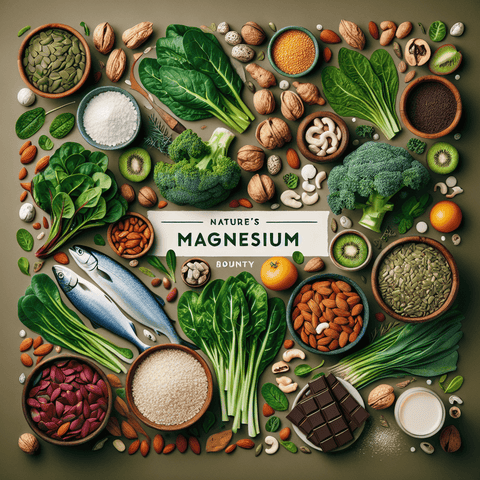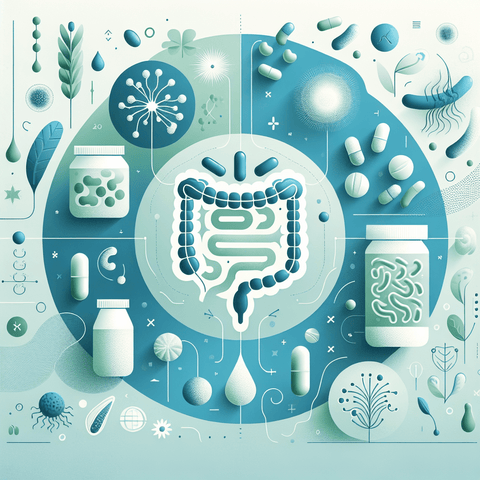Introduction
Magnesium is an essential mineral that plays a vital role in over 300 enzymatic processes in the human body. From supporting muscle function and nerve signaling to regulating blood pressure and facilitating energy production, magnesium is one nutrient that should not be overlooked. Despite its significance, magnesium deficiency is surprisingly common, especially in modern diets that are high in processed foods and low in whole, nutrient-dense ingredients. Incorporating magnesium-rich foods into your daily diet is a practical and natural way to boost your magnesium intake. While dietary supplements offer a convenient solution—especially for individuals with certain health conditions or dietary restrictions—whole foods remain the foundational source of this important mineral. Eating a variety of magnesium-containing foods can help improve your energy levels, support cardiovascular health, and enhance bone integrity. The purpose of this article is to offer a detailed look at the most effective natural sources of magnesium. You’ll discover which foods are highest in magnesium, learn how to best prepare and enjoy them, and understand when supplementation might be necessary. Whether you're focused on boosting energy, enhancing athletic performance, or simply supporting overall wellness, this guide on magnesium-rich foods is your go-to resource for balancing minerals naturally.Magnesium-Rich Foods: Natural Sources of this Essential Mineral
One of the most efficient ways to nourish your body with magnesium is through food. Magnesium-rich foods offer a whole-food matrix of nutrients that work synergistically to support health. Unlike isolated supplements, foods provide fiber, antioxidants, and other vitamins and minerals that enhance absorption and effectiveness. Obtaining magnesium from whole foods also aids in the regular intake needed to address and prevent magnesium deficiency. According to the European Food Safety Authority (EFSA), adult daily requirements for magnesium range from 300 to 375 mg per day. Yet, inadequate consumption is widespread, which can result in symptoms like fatigue, muscle cramps, and impaired glucose tolerance. Whole-food dietary sources of magnesium also provide long-term benefits. Their bioavailability—the extent to which the nutrient is absorbed and utilized in the body—is generally high with minimal side effects. Incorporating a combination of magnesium-rich foods such as leafy greens, nuts, seeds, and whole grains into your daily meal plan can ensure a steady supply of this essential mineral. Supplements can certainly help those who struggle to meet daily magnesium needs through diet alone, especially individuals with gastrointestinal disorders, certain medications, or increased needs. If you're considering supplementation, it's essential to consult with a healthcare provider and choose high-quality products like those found in the Topvitamine magnesium assortment, which offer formulations designed for optimal absorption and mineral balance.Leafy Green Vegetables
Leafy greens are among the most nutritious plant-based sources of magnesium. Not only are they packed with chlorophyll—where magnesium is the central atom—but they also offer iron, potassium, fiber, and a range of phytochemicals with antioxidant properties. Spinach is a prime example of a magnesium-dense green. One cup of cooked spinach provides approximately 157 mg of magnesium, covering over 40% of the recommended daily intake. Swiss chard is another excellent source, delivering roughly 150 mg per cooked cup. Other greens like kale and collard greens also contribute meaningful amounts of magnesium, although to a lesser extent. A key benefit of leafy greens is their versatility. You can enjoy them in salads, blended into smoothies, sautéed with garlic, or added to soups and stews. To maximize magnesium intake, opt for light steaming or sautéing, which preserves the nutrients better than boiling. Adding a source of healthy fat, like olive oil, can improve the bioavailability of fat-soluble vitamins that these greens also provide. In addition to being easy to incorporate into meals, leafy green vegetables are ideal for those following vegetarian, vegan, or dairy-free diets. They also provide a valuable contribution to cardiovascular health thanks to their fiber and potassium content, further enhancing their appeal as a staple in magnesium-rich dietary patterns. For individuals looking to track their magnesium intake or create a more structured nutrition plan, adding more leafy greens to main dishes or side items is a simple, effective strategy. Consistent consumption can significantly support mineral balance, especially when paired with other foods featured in this guide.Nuts and Seeds
Nuts and seeds rank among the highest sources of magnesium in compact, calorie-dense packages. They make ideal snacks and cooking additions, providing not only magnesium but also beneficial unsaturated fats, plant proteins, and antioxidants. Their convenience and shelf-life also make them a great pantry staple. Almonds lead the pack, offering around 80 mg of magnesium per 28-gram serving (roughly a small handful). Cashews and peanuts are also notable contributors, with cashews providing about 74 mg per serving. Pumpkin seeds (also called pepitas) are arguably the most magnesium-dense seed, supplying an impressive 150 mg in just a 28-gram serving. Sunflower seeds contribute nearly 100 mg, making them another solid option. Because nuts and seeds are versatile, they can be eaten alone, included in trail mixes, or used as toppings for salads, oatmeal, yogurt, and smoothie bowls. Ground nut and seed butters like almond or sunflower butter also retain their magnesium content and are excellent spreads for toast or fruit. Beyond their magnesium concentration, nuts and seeds contain vital nutrients such as Vitamin E, zinc, selenium, and omega-3 fatty acids—particularly in walnuts and chia seeds. Including them in your meals not only aids mineral replenishment but also supports heart, brain, and skin health. Another strategy for maximizing benefits is soaking and sprouting seeds and nuts, which can reduce phytic acid and enhance nutrient bioavailability. While this step isn’t essential, it can be particularly beneficial for those with digestive issues or specialized dietary needs. Adding a variety of nuts and seeds to your diet is a simple and impactful way to ensure adequate magnesium intake. When paired with whole grains or leafy greens, you create synergy that enhances overall mineral absorption while delivering well-rounded nutritional support.Whole Grains
Whole grains are another vital category of magnesium dietary sources. Unlike their refined counterparts, whole grains retain the bran and germ, both of which are rich in minerals like magnesium, manganese, and phosphorous. This makes unprocessed grains a superior option for building a magnesium-rich eating pattern. Quinoa, a gluten-free pseudo-grain, contains about 118 mg of magnesium per cooked cup. It’s also a complete protein, making it ideal for vegetarians and vegans. Brown rice supplies around 86 mg of magnesium per cooked cup, while oats deliver roughly 57 mg per cup and wheat bran tops the list with about 350 mg per 100 grams. Incorporating whole grains into your daily meals is easy. Use quinoa as a base for grain bowls, mix oats into breakfast porridge or smoothies, and opt for whole-grain varieties of bread, pasta, and cereals over refined options. When baking, consider adding wheat bran or oat bran to boost magnesium content. Choosing minimally processed or fortified whole grains ensures a better nutritional profile. When grains are processed, much of their magnesium is lost during refinement. For example, white rice and white bread contain significantly less magnesium compared to their whole-grain versions. Whole grains also offer the benefit of fiber—aiding digestion and glycemic control—and contain phytochemicals that act as antioxidants. Including a wide variety of these grains supports not only your magnesium levels but also overall metabolic and intestinal health. By thoughtfully combining whole grains with other magnesium-rich foods such as legumes, vegetables, and healthy fats, you can create nutrient-dense, satisfying meals that align with longevity and vitality goals. For those seeking additional support, magnesium supplements remain an accessible option, especially quality choices from Topvitamine’s magnesium collection.Legumes
Legumes, including beans, lentils, peas, and chickpeas, are phenomenal natural sources of magnesium. They’re widely accessible, cost-effective, and full of plant-based protein, fiber, folate, and iron. Their unique nutritional profile makes them especially advantageous for vegetarians and people seeking to manage blood sugar and cholesterol levels. Black beans are a standout legume for magnesium, offering 120 mg per cooked cup. Lentils follow with around 71 mg per cooked cup, and chickpeas trail slightly behind at roughly 79 mg. Other notable options include kidney beans and navy beans, which also provide upwards of 60 mg per cup. Legumes are easy to integrate into both everyday and gourmet meals. Enjoy them in soups, curries, and stews, or mix them cold into salads. They’re also an excellent filling for wraps, burritos, and grain bowls. Canned legumes offer convenience, though it’s advisable to rinse them thoroughly to reduce sodium content. Soaking dried legumes before cooking can reduce compounds like lectins and phytic acid, enhancing their digestibility and mineral absorption. Cooking legumes thoroughly also improves their texture and palatability, making them a desirable staple even for picky eaters. Beyond their magnesium content, legumes contribute to satiety owing to their high fiber and protein levels. This makes them valuable in weight management and glycemic control plans, while also delivering sustained energy throughout the day. People on special diets, such as gluten-free or dairy-free, can also benefit from making legumes a central focus in their meal rotation. For intensified mineral absorption, consider pairing legumes with a vitamin C-rich food like tomatoes or bell peppers, or enrich your diet with supportive magnesium supplements when needed.Fish and Seafood
Fatty fish and select shellfish offer another valuable source of magnesium, along with the added benefit of omega-3 fatty acids, high-quality protein, and Vitamin D. These nutrients collectively support heart health, inflammation modulation, brain function, and bone metabolism. Salmon is one of the most nutritious fish globally available and contains around 26 mg of magnesium per 100 grams. Mackerel and halibut also contribute significantly, with halibut delivering an impressive 91 mg per 100-gram serving. Other magnesium-bearing seafood options include tuna, crab, and shrimp, which offer moderate amounts. Fatty fish are particularly beneficial in balanced diets because they deliver magnesium alongside omega-3s like DHA and EPA. These fats are essential for brain development, cardiovascular health, and immune function. For those interested in boosting omega-3 intake, you can also explore products from the Topvitamine omega-3 supplement range. Incorporating fish into your diet at least twice a week is consistent with both Mediterranean and Nordic dietary guidelines. Prepare grilled salmon for dinner, enjoy tuna salad wraps for lunch, or toss smoked mackerel into pasta dishes. When possible, select wild-caught and sustainably sourced seafood to ensure both optimal nutritional value and environmental responsibility. Seafood may not be ideal for all diets, especially vegetarian or vegan individuals. However, magnesium supplementation and plant-based alternatives like algae oil omega-3 capsules offer a solution for maintaining nutrient balance. Because of its broad nutritional profile, fish and seafood remain essential contributors to overall health, especially when considering their role alongside magnesium in energy metabolism and muscle function.Dark Chocolate
Dark chocolate often surprises people as a legitimate source of magnesium. When chosen carefully, it can deliver satisfying flavor along with impressive nutritional value—making it a guilt-free indulgence when consumed in moderation. A 28-gram serving (about one ounce) of dark chocolate with at least 70–85% cacao contains approximately 64 mg of magnesium. In addition, it provides iron, copper, manganese, and a spectrum of antioxidants, particularly flavonoids, which support heart and cognitive health. The key to maximizing the benefits of dark chocolate lies in selecting high-quality products with minimal added sugars. Look for chocolate that contains cocoa mass as the first ingredient, avoids hydrogenated oils, and lists at least 70% cacao content on the label. Dark chocolate can be enjoyed as a snack, grated over oatmeal, melted into smoothies, or included in healthy desserts. While it does contain fat and should be eaten in moderation, its combination of taste and nutrient density makes it an appealing option for those balancing wellness with culinary pleasure. It’s important to note that while chocolate contains oxalates—compounds that can interfere with magnesium absorption—its high overall content of the mineral still makes it a net positive for most people. Dark chocolate’s antioxidant effects and mineral content support multiple physiological systems, making it a valuable addition to a holistic diet. For individuals requiring more consistent magnesium intake across meals, supplementation remains a practical tool, particularly through nutrient-verified choices available at Topvitamine Magnesium.How to Incorporate These Magnesium-Rich Foods into Your Diet for Optimal Health
Creating a magnesium-rich diet doesn’t mean overhauling your eating habits overnight. Instead, start with small, sustainable changes and aim to gradually incorporate more whole foods that are naturally rich in this mineral. For breakfast, consider oatmeal topped with pumpkin seeds, dark chocolate shavings, and almond butter. At lunch, opt for a quinoa and kale salad with chickpeas, sunflower seeds, and a lemon-olive oil dressing. Dinner could feature grilled salmon paired with lentils and steamed Swiss chard. Snacks might include a handful of almonds or a homemade trail mix with cashews and dried cranberries. Combining different magnesium sources in a single meal may improve overall nutrient availability due to synergies in absorption. For vegetarians and vegans, prioritizing whole grains, legumes, leafy greens, nuts, and seeds on a regular basis provides an excellent foundation for meeting daily magnesium needs without reliance on animal products. Those who struggle with digestive concerns may find that magnesium-rich liquids like green smoothies or soups are gentler on the system. For enhanced absorption and reduced loss, avoid overly processed foods, limit alcohol, and minimize calcium-heavy meals when planning your magnesium-rich diet, as high calcium can compete for absorption. Supplements offer another layer of consistency, especially when dietary adherence is challenging. Look for reputable sources of magnesium such as the Topvitamine magnesium collection, and always consult a healthcare provider before beginning supplementation, especially if you take medications or have existing health conditions.The Role of Magnesium Supplements and When to Consider Them
Despite best efforts, some individuals may still fall short of their magnesium needs due to dietary restrictions, illness, or absorption issues. In such cases, magnesium supplements provide a helpful backup strategy. Groups at higher risk for magnesium deficiency include older adults, people with type 2 diabetes, individuals taking diuretics or proton-pump inhibitors, and those who consume highly processed diets. Symptoms of deficiency can include muscle cramps, fatigue, irregular heartbeats, and sleep disturbances. Magnesium supplements come in various forms, including magnesium citrate, glycinate, oxide, and chloride. Each has different absorption rates and uses; for example, magnesium citrate is often used for digestion, while glycinate is frequently chosen for its calming effects. When selecting a magnesium supplement, be sure to choose high-quality options free from unnecessary fillers and additives. Topvitamine’s magnesium range offers scientifically-formulated products that help address different wellness goals, from energy maintenance to bone health. Always consult your healthcare provider before starting supplementation, especially if you're pregnant, lactating, or managing chronic disease. Magnesium should be taken in appropriate dosages, as excess intake can cause gastrointestinal issues such as diarrhea. Diet should remain the cornerstone of magnesium intake, with supplements acting as supportive tools to fine-tune your levels and offer consistency when needed.Conclusion
Magnesium is a foundational mineral that supports virtually every system in the body, from muscle and nerve function to cardiovascular and bone health. Consistently eating magnesium-rich foods is an effective, natural way to maintain optimal levels and minimize deficiency risk. By focusing on natural sources—such as leafy greens, nuts, seeds, whole grains, legumes, fish, and even dark chocolate—you not only boost your magnesium intake but also support overall nutrition with fiber, healthy fats, protein, and powerful antioxidants. Whether you're optimizing athletic performance, managing stress, or simply supporting health through nutrition, magnesium-rich foods are vital components of a balanced diet. When dietary intake proves insufficient, quality magnesium supplements offer reliable support. For trusted products, consider the broad range offered by Topvitamine. Achieving adequate magnesium levels is both an art and a science—balancing what you eat with how your body absorbs and utilizes it. Begin with intention, stay consistent, and empower your wellness journey through nutrient-rich food choices.Q&A Section
Q1: What are the top food sources highest in magnesium?A: The top sources include spinach, Swiss chard, pumpkin seeds, almonds, cashews, quinoa, black beans, mackerel, and dark chocolate (70% cacao or more). Q2: Can I get enough magnesium through food alone?
A: Yes, many people can meet their daily magnesium needs through a well-balanced diet. However, those with health issues or dietary restrictions may benefit from supplements for added support. Q3: What are the symptoms of magnesium deficiency?
A: Symptoms include fatigue, muscle cramps, weakness, irritability, and arrhythmias. Chronic deficiency can impact bone health and metabolic function. Q4: Are magnesium supplements safe?
A: When taken at recommended doses and sourced from reputable brands like Topvitamine, magnesium supplements are generally well tolerated. Consult a healthcare provider before use. Q5: Can vegetarians and vegans easily get enough magnesium?
A: Yes, plant-based magnesium sources like legumes, whole grains, nuts, seeds, and leafy greens are excellent for vegetarians and vegans and can fulfill daily requirements.



